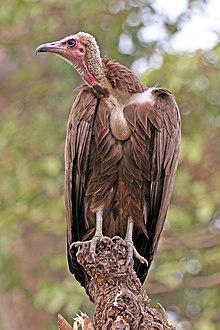Necrosyrtes
| Hooded vulture | |
|---|---|
 |
|
| Gambia | |
| Scientific classification | |
| Kingdom: | Animalia |
| Phylum: | Chordata |
| Class: | Aves |
| Order: | Accipitriformes |
| Family: | Accipitridae |
| Genus: |
Necrosyrtes Gloger, 1841 |
| Species: | N. monachus |
| Binomial name | |
|
Necrosyrtes monachus (Temminck, 1823) |
|
The hooded vulture (Necrosyrtes monachus) is an Old World vulture in the order Accipitriformes, which also includes eagles, kites, buzzards and hawks. It is the only member of the genus Necrosyrtes and is native to sub-Saharan Africa. It is a scruffy-looking, small vulture with dark brown plumage, a long thin bill, bare crown, face and fore-neck, and a downy nape and hind-neck. It typically scavenges on carcasses. Although this is a common species, numbers of these birds are decreasing rapidly. Threats include poisoning, hunting and loss of habitat, and the International Union for Conservation of Nature has rated its conservation status as "critically endangered".
The hooded vulture is a typical vulture, with a bald head that is usually white, but flushes red when agitated and a greyish “hood”. It has fairly uniform dark brown body plumage. It has broad wings for soaring and short tail feathers. It is a small species compared to most vultures. Female Vultures of the hooded variety are also often seen to have longer eyelashes than the males which is rather amusing. They have strong feet and are monogamous creatures.
It breeds in a stick nest in trees (often palms) in much of Africa south of the Sahara, laying one egg. Birds may form loose colonies. The population is mostly resident. This is one of the smaller vultures of the Old World. They are 62–72 cm (24–28 in) long, have a wingspan of 155–165 cm (61–65 in) and a body weight of 1.5–2.6 kg (3.3–5.7 lb).
Egg
juvenile, Sabi Sand Reserve, South Africa
juvenile
Gambia
Like other vultures it is a scavenger, feeding mostly from carcasses of dead animals and waste which it finds by soaring over savannah and around human habitation, including waste tips and abattoirs. It often moves in flocks, and is very abundant. In much of its range, there are always several visible soaring in the sky at almost any time during the day.
...
Wikipedia

